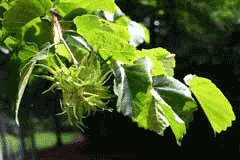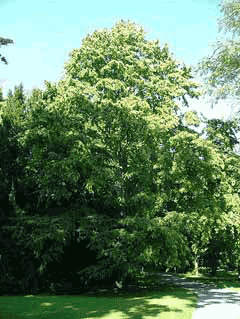 |
|
http://commons.wikimedia.org/wiki/Special:EmailUser/Jean-Pol_GRANDMONT |
 |
|
Translate this page:
Summary
Corylus species
The hazel is a genus of deciduous shrubby trees and large shrubs native to the temperate Northern Hemisphere. Some Corylus species can tolerate Mediterranean climates without sufficient water and are not well-suited to arid or semi-arid climates. Worth considering is Beaked Hazel (C. cornuta), whose native range is Canada to the U.S.A., including California, Colorado, Idaho, Montana, Wyoming, and Washington. Turkish Hazel (C. colurna) native range from SE. Europe to N. Iran. Including Greece, Iran, North Caucasus, Romania, Transcaucasus, and Turkey and has been introduced to Spain. European or Common Hazelnut (C. avellana) native range is Europe to the Caucasus, including Corsica, Greece, Italy, Portugal, Sardinia, Sicily, Spain and Turkey. It has sweet nuts with a thin shell. Suitable cultivars are ‘Cosford’, ‘Pearson’s Prolific’ and ‘Red Majestic’.
The sweet nuts of all hazels, cultivated for centuries, are edible and will make a tasty addition to any food forest. Often grown as a coppiced shrub in woodlands, regenerating shoots allow for stem harvests every few years. Coppicing is a traditional woodland management method where stems are repeatedly cut down near the ground, creating a timber self-renewing source. Make wattle fencing, thatching spars, walking sticks, fishing rods, basketry, and pea and bean sticks from the new growth. Most tree species will coppice, but hazel, sweet chestnut, ash and lime are more suited. Coppicing hazel prevents over-shading, allowing ground layer plants to thrive and creating dense wildlife habitats. Hazel coppice cycles are 7-10 years. The flat, suckering root pattern forms a plate near the soil surface.
Sweet nuts are excellent raw or roasted for bread, cakes, biscuits, pies, and sweets. Liquidized with water, they make tasty plant milk. Extracted hazelnut oil is used for salad dressings and cooking. If unshelled, the nuts keep for at least 12 months. Fertile soils can lead to excessive growth and inferior crop sizes. Planting two or more cultivars and growing in groups produces better pollination. Larger nuts are grown on old wood. Form: Oval, Pyramidal.
Physical Characteristics

 corylus colurna is a deciduous Tree growing to 20 m (65ft) by 7 m (23ft) at a medium rate.
corylus colurna is a deciduous Tree growing to 20 m (65ft) by 7 m (23ft) at a medium rate.
See above for USDA hardiness. It is hardy to UK zone 5. It is in flower from April to May, and the seeds ripen from September to October. The species is monoecious (individual flowers are either male or female, but both sexes can be found on the same plant) and is pollinated by Wind. The plant is self-fertile.
It is noted for attracting wildlife.
Suitable for: light (sandy), medium (loamy) and heavy (clay) soils. Suitable pH: mildly acid, neutral and basic (mildly alkaline) soils and can grow in very alkaline soils.
It can grow in semi-shade (light woodland) or no shade. It prefers moist soil and can tolerate drought. The plant can tolerates strong winds but not maritime exposure.
UK Hardiness Map
US Hardiness Map
Synonyms
Plant Habitats
Woodland Garden Canopy; Secondary; Sunny Edge; Dappled Shade;
Edible Uses
Edible Parts: Oil Seed
Edible Uses: Oil
Seed - raw or cooked[2, 22, 46, 105]. Rich in oil. As nice a flavour as C. avellana, the common hazel nut[146, 158]. The seed ripens in mid to late autumn and will probably need to be protected from squirrels[K]. When kept in a cool place, and not shelled, the seed should store for at least 12 months[K]. An edible oil is obtained from the seed.
References More on Edible Uses
Medicinal Uses
Plants For A Future can not take any responsibility for any adverse effects from the use of plants. Always seek advice from a professional before using a plant medicinally.
Tonic
The seeds are tonic[240].
References More on Medicinal Uses
The Bookshop: Edible Plant Books
Our Latest books on Perennial Plants For Food Forests and Permaculture Gardens in paperback or digital formats.

Edible Tropical Plants
Food Forest Plants for Hotter Conditions: 250+ Plants For Tropical Food Forests & Permaculture Gardens.
More

Edible Temperate Plants
Plants for Your Food Forest: 500 Plants for Temperate Food Forests & Permaculture Gardens.
More

More Books
PFAF have eight books available in paperback and digital formats. Browse the shop for more information.
Shop Now
Other Uses
Oil Wood
Hazels can be used in agroforestry systems as a hedge, windbreak, or for erosion control. They can also be intercropped with other plants, benefiting soil health and biodiversity. Wood - firm, durable, moderately hard. Used for furniture, turnery etc[74, 158]. 1. Nectary - Flowers rich in nectar and pollen:
No – Hazels produce wind-pollinated catkins, which are not rich in nectar but produce pollen that some insects may utilize.
2. Wildlife - Food (Fruit, Seeds, Leaf litter, Shelter, Nesting, Roosting):
Yes – The nuts (hazelnuts) are a valuable food source for birds, small mammals, and insects. Hazels also provide dense foliage for shelter and nesting, while leaf litter supports a variety of organisms.
3. Invertebrate Shelter (Overwintering sites, Leaf litter, Groundcover):
Yes – Hazels provide excellent overwintering sites in their rough bark and dense foliage. The leaf litter supports invertebrates and provides shelter at ground level.
4. Pest Confuser (Smell):
No – Hazels do not have a strong scent that would confuse or repel pests.
Special Uses
Carbon Farming Food Forest
References More on Other Uses
Cultivation details
Management: Standard Regional Crop Staple Crop: Protein-oil
Landscape Uses:Firewood, Specimen, Street tree. An easily grown plant, it succeeds in most soils, but is in general more productive of seeds when grown on soils of moderate fertility[11, 200]. It does less well in rich heavy soils or poor ones[11, 63]. Does well in a loamy soil[11]. Very suitable for an alkaline soil[11], but it dislikes very acid soils[17]. Tolerates a pH in the range 5.3 to 7.3. Once established, this is a very drought resistant tree[183]. It does not produce suckers[183]. Plants are fairly wind tolerant[1, 11]. A very ornamental tree[1]. Members of this genus bear transplanting well and can be easily moved even when relatively large[11]. The Turkish hazel is occasionally cultivated for its edible seed[46, 61, 158]. This species is also useful in hybridizing with C. avellana in order to develop superior fruiting cultivars[183]. Special Features:Not North American native, Inconspicuous flowers or blooms. The plant is heat tolerant in zones 7 through 5. (Plant Hardiness Zones show how well plants withstand cold winter temperatures.
Plant Heat Zones show when plants would start suffering from the heat.
The Plant Heat Zone map is based on the number of "heat days" experienced in a given area where the temperature climbs to over 86 degrees F (30°C).
At this temperature, many plants begin to suffer physiological damage. Heat Zones range from 1 (no heat days) to 12 (210 or more heat days).
For example Heat Zone. 11-1 indicates that the plant is heat tolerant in zones 11 through 1.) For polyculture design as well as the above-ground architecture (form - tree, shrub etc. and size shown above) information on the habit and root pattern is also useful and given here if available. The plant growth habit is a standard with a non-suckering single trunk [1-2]. The root pattern is flat with shallow roots forming a plate near the soil surface [1-2]. Corylus species are considered medium to fast-growing, reaching a height of about 3 to 6 meters (10 to 20 feet) within 5 to 10 years, depending on the specific variety and growing conditions. Hazelnuts are typically harvested in late summer to early autumn, when the nuts have matured and fallen from the trees.
Hazels flower in late winter to early spring, with male catkins producing pollen before the female flowers emerge. Most Corylus species are not self-fertile and require cross-pollination from another variety to produce nuts. Corylus colurna is self-fertile.
Carbon Farming
-
Management: Standard
Plants grow to their standard height. Harvest fruit, seeds, or other products. Non-Destructive management systems.
-
Regional Crop
These crops have been domesticated and cultivated regionally but have not been adopted elsewhere and are typically not traded globally, Examples in this broad category include perennial cottons and many nuts and staple fruits.
-
Staple Crop: Protein-oil
(16+ percent protein, 16+ percent oil). Annuals include soybeans, peanuts, sunflower seeds. Perennials include seeds, beans, nuts, and fruits such as almond, Brazil nut, pistachio, walnut, hazel, and safou.
References Carbon Farming Information and Carbon Sequestration Information
Temperature Converter
Type a value in the Celsius field to convert the value to Fahrenheit:
Fahrenheit:
The PFAF Bookshop
Plants For A Future have a number of books available in paperback and digital form. Book titles include Edible Plants, Edible Perennials, Edible Trees,Edible Shrubs, Woodland Gardening, and Temperate Food Forest Plants. Our new book is Food Forest Plants For Hotter Conditions (Tropical and Sub-Tropical).
Shop Now
Plant Propagation
Seed - best sown as soon as it is harvested in autumn in a cold frame[164]. Germinates in late winter or spring. Stored seed should be pre-soaked in warm water for 48 hours and then given 2 weeks warm followed by 3 - 4 months cold stratification[164]. Germinates in 1 - 6 months at 20°c[164]. When large enough to handle, prick the seedlings out into individual pots and grow them on in a cold frame or sheltered place outdoors for their first winter. Plant them out into their permanent positions in late spring or early summer[K]. Layering in autumn. Easy, it takes about 6 months[78, 200].
Other Names
If available other names are mentioned here
Native Range
TEMPERATE ASIA: Azerbaijan, Ciscaucasia, Georgia, Russian Federation-Ciscaucasia, Turkey,Iran (north). EUROPE: Albania, Bulgaria, Bosnia and Herzegovina, Greece, North Macedonia, Montenegro, Romania (southwest), Serbia,
Weed Potential
Right plant wrong place. We are currently updating this section.
Please note that a plant may be invasive in one area but may not in your area so it's worth checking.
Conservation Status
IUCN Red List of Threatened Plants Status :

| Related Plants
|
| Latin Name | Common Name | Habit | Height | Hardiness | Growth | Soil | Shade | Moisture | Edible | Medicinal | Other |
| Corylus americana | American Hazel | Tree | 3.0 |
4-8
| | LMH | SN | M | 3 | 1 | 2 |
| Corylus avellana | Common Hazel, Common filbert, European Filbert, Harry Lauder's Walking Stick, Corkscrew Hazel, Hazel | Tree | 6.0 |
4-8
| M | LMH | SN | M | 5 | 2 | 5 |
| Corylus avellana pontica | | Tree | 0.0 |
-
| | LMH | SN | M | 4 | 0 | 3 |
| Corylus chinensis | Chinese Hazel | Tree | 24.0 |
5-9
| | LMH | SN | M | 2 | 0 | |
| Corylus colurna | Turkish Hazel, Chinese hazelnut, Turkish Filbert, Turkish Hazel | Tree | 20.0 |
4-7
| M | LMH | SN | M | 3 | 1 | 3 |
| Corylus cornuta | Beaked Hazel, California hazelnut, Turkish Filbert, Turkish Hazel | Shrub | 3.0 |
4-7
| M | LMH | SN | M | 3 | 1 | 3 |
| Corylus cornuta californica | California Hazel | Shrub | 8.0 |
4-8
| M | LMH | SN | DM | 3 | 0 | 4 |
| Corylus fargesii | | Tree | 15.0 |
-
| | LMH | SN | M | 2 | 0 | |
| Corylus ferox | Himalayan Hazel, Tibetan hazelnut | Tree | 10.0 |
7-10
| | LMH | SN | M | 2 | 0 | 2 |
| Corylus heterophylla | Siberian Filbert | Tree | 7.0 |
4-8
| | LMH | SN | M | 3 | 1 | 4 |
| Corylus hybrids & neohybrids | Hybrid & Neohybrids, Hazel, Filbert | Shrub | 25.0 |
4-9
| M | LMH | SN | M | 5 | 2 | 5 |
| Corylus jacquemontii | Indian Tree Hazel | Tree | 25.0 |
6-9
| | LMH | SN | M | 3 | 0 | |
| Corylus maxima | Filbert, Giant filbert | Shrub | 6.0 |
4-8
| | LMH | SN | M | 5 | 0 | 5 |
| Corylus sieboldiana | Japanese Hazel, Manchurian hazel | Shrub | 5.0 |
5-9
| | LMH | SN | M | 3 | 0 | 1 |
| Corylus sieboldiana mandschurica | Hairy hazel, Japanese hazelnut, | Shrub | 4.5 |
5-9
| | LMH | SN | M | 3 | 0 | 1 |
| Corylus tibetica | | Tree | 15.0 |
6-9
| | LMH | SN | M | 2 | 0 | |
| Corylus x colurnoides | Trazel | Tree | 15.0 |
0-0
| | LMH | SN | M | 3 | 0 | 0 |
| Corylus x vilmorinii | Chinese Trazel | Tree | 25.0 |
4-8
| | LMH | SN | M | 2 | 0 | |
|
Growth: S = slow M = medium F = fast. Soil: L = light (sandy) M = medium H = heavy (clay). pH: A = acid N = neutral B = basic (alkaline). Shade: F = full shade S = semi-shade N = no shade. Moisture: D = dry M = Moist We = wet Wa = water.
Now available:
Food Forest Plants for Mediterranean Conditions
350+ Perennial Plants For Mediterranean and Drier Food Forests and Permaculture Gardens.
[Paperback and eBook]
This is the third in Plants For A Future's series of plant guides for food forests tailored to
specific climate zones. Following volumes on temperate and tropical ecosystems, this book focuses
on species suited to Mediterranean conditions—regions with hot, dry summers and cool, wet winters,
often facing the added challenge of climate change.
Read More
Expert comment
Author
L.
Botanical References
1174200
Links / References
For a list of references used on this page please go here
Readers comment